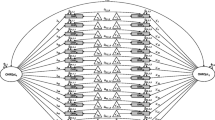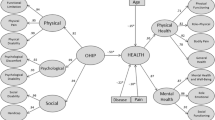Abstract
Objectives
Aims were to investigate and compare the validity and reliability of Oral Health Impact Profile (OHIP) scores referencing 7-day and 1-month recall periods in international prosthodontic patients.
Material and methods
A sample of 267 patients (mean age = 54.0 years, SD = 17.2 years, 58 % women) with stable oral health-related quality of life was recruited from prosthodontic treatment centers in Croatia, Germany, Hungary, Japan, Slovenia, and Sweden. These patients completed the OHIP on two occasions using a new 7-day recall period and the traditional 1-month recall period. OHIP score validity and reliability were investigated with structural equation models (SEMs) that included OHIPpast 7 days and OHIP1 month latent factors and single indicator measures of global oral health status. The SEMs assessed measurement invariance and the relative validities of the two OHIP latent factors (representing the two recall periods).
Results
The SEMs provided cogent evidence for recall period measurement invariance for the two OHIP forms and equal validities (r = .48) with external measures of global oral health status.
Conclusion
When assessed in international prosthodontic patients, OHIP scores using the new 7-day recall period were as reliable and valid as the scores using the 1-month recall period.
Clinical relevance
Conceptual advantages make a 7-day recall period a preferred frame of reference in clinical applications of the OHIP questionnaire.

Similar content being viewed by others
Notes
Our previous findings [17] indicated that in addition to a strong general factor of OHRQoL, the OHIP measures four weaker group factors that describe specific aspects of oral health (Oral Function, Orofacial Pain, Orofacial Appearance, and Psychosocial Impact). It is likely that inclusion of these weaker factors into our latent variable models would have improved the recovery of all item correlations. Unfortunately, our multisite samples were not sufficiently large to enable us to rigorously evaluate these more complex latent variable models.
References
López R, Baelum V (2007) Oral health impact of periodontal diseases in adolescents. J Dent Res 86:1105–1109
Slade GD (1997) The Oral Health Impact Profile. In: Slade GD (ed) Measuring Oral Health and Quality of Life. University of North Carolina, Department of Dental Ecology, Chapel Hill, pp 93–104
Adulyanon S, Sheiham A (1997) Oral Impacts on Daily Performances. In: Slade GD (ed) Measuring Oral Health and Quality of Life. University of North Carolina, Department of Dental Ecology, Chapel Hill, pp 151–160
Dolan TA, Gooch BR (1997) Dental Health Questions from the RAND Health Insurance Study. In: Slade GD (ed) Measuring Oral Health and Quality of Life. University of North Carolina, Department of Dental Ecology, Chapel Hill, pp 65–70
Schneider S, Choi SW, Junghaenel DU, Schwartz JE, Stone AA (2013) Psychometric characteristics of daily diaries for the Patient-Reported Outcomes Measurement Information System (PROMIS): a preliminary investigation. Qual Life Res 22:1859–1869
Slade GD, Spencer AJ (1994) Development and evaluation of the Oral Health Impact Profile. Community Dent Health 11:3–11
John MT, Reissmann DR, Feuerstahler L, Waller N, Baba K, Larsson P, Celebic A, Szabo G, Rener-Sitar K (2014) Factor analyses of the Oral Health Impact Profile - overview and studied population. J Prosthodont Res 58:26–34
Szentpetery A, Szabo G, Marada G, Szanto I, John MT (2006) The Hungarian version of the Oral Health Impact Profile. Eur J Oral Sci 114:197–203
Petricevic N, Celebic A, Papic M, Rener-Sitar K (2009) The Croatian version of the Oral Health Impact Profile Questionnaire. Coll Antropol 33:841–847
John MT, Patrick DL, Slade GD (2002) The German version of the Oral Health Impact Profile–translation and psychometric properties. Eur J Oral Sci 110:425–433
Rener-Sitar K, Celebic A, Petricevic N, Papic M, Sapundzhiev D, Kansky A, Marion L, Kopac I, Zaletel-Kragelj L (2009) The Slovenian version of the Oral Health Impact Profile Questionnaire (OHIP-SVN): translation and psychometric properties. Coll Antropol 33:1177–1183
Larsson P, List T, Lundstrom I, Marcusson A, Ohrbach R (2004) Reliability and validity of a Swedish version of the Oral Health Impact Profile (OHIP-S). Acta Odontol Scand 62:147–152
Yamazaki M, Inukai M, Baba K, John MT (2007) Japanese version of the Oral Health Impact Profile (OHIP-J). J Oral Rehabil 34:159–168
StataCorp (2013) Stata Statistical Software, Release 13. StataCorp LP, College Station, TX
Locker D (1988) Measuring oral health: a conceptual framework. Community Dent Health 5:3–18
R Core Team (2014) R: a language and environment for statistical computing. The R Foundation for Statistical Computing, Vienna, Austria. http://www.r-project.org/. Accessed 21 January 2015
John MT, Feuerstahler L, Waller N, Baba K, Larsson P, Celebic A, Kende D, Rener-Sitar K, Reißmann DR (2014) Confirmatory factor analysis of the Oral Health Impact Profile. J Oral Rehabil 41:644–652
John MT, Reißmann DR, Feuerstahler L, Waller N, Baba K, Larsson P, Celebic A, Szabo G, Rener-Sitar K (2014) Exploratory factor analysis of the Oral Health Impact Profile. J Oral Rehabil 41:635–643
Cronbach LJ (1951) Coefficient alpha and the internal structure of tests. Psychometrika 16:297–334
Duhachek A, Iacobucci D (2004) Alpha’s standard error (ASE): an accurate and precise confidence interval estimate. J Appl Psychol 89:792–808
Fisher RA (1915) Frequency distribution of the values of the correlation coefficient in samples from an indefinitely large population. Biometrika 10:507–521
Steiger JH (1980) Tests for comparing elements of a correlation matrix. Psychol Bull 87:245–251
Kline RB (2011) Principles and practice of structural equation modeling. Guilford press, New York
Jöreskog KG, Sörbom D, SPSS Inc (1996) LISREL 8 user’s reference guide. Scientific Software International, Chicago, IL
Rosseel Y (2012) lavaan: an R Package for Structural Equation Modeling. J Stat Softw 48:1–36
Nye CD, Drasgow F (2010) Assessing goodness of fit: simple rules of thumb simply do not work. Organ Res Methods 14:548–570
Bentler PM, Wu EJC (1995) EQS for Windows user’s guide. Multivariate Software, Encino, CA
Steiger JH, Lind JM (1980) Statistically-based tests for the number of common factors. Paper presented at the annual spring meeting of the Psychometric Society. Iowa City, IA
Bentler PM (1990) Comparative fit indexes in structural models. Psychol Bull 107:238–246
Tucker LR, Lewis C (1973) A reliability coefficient for maximum likelihood factor analysis. Psychometrika 38:1–10
Jöreskog KG, Sörbom D (1984) LISREL VI: analysis of linear structural relationships by maximum likelihood, instrumental variables, and least squares methods, 3rd edn. Scientific Software, Mooresville, IN
Gregorich SE (2006) Do self-report instruments allow meaningful comparisons across diverse population groups? Testing measurement invariance using the confirmatory factor analysis framework. Med Care 44(11 Suppl 3):S78–S94
John MT, Reissmann DR, Szentpétery A, Steele J (2009) An approach to define clinical significance in prosthodontics. J Prosthodont 18:455–460
van der Meulen MJ, John MT, Naeije M, Lobbezoo F (2008) The Dutch version of the Oral Health Impact Profile (OHIP-NL): translation, reliability and construct validity. BMC Oral Health 8:11
Al-Jundi MA, Szentpétery A, John MT (2007) An Arabic version of the Oral Health Impact Profile: translation and psychometric properties. Int Dent J 57:84–92
Sutinen S, Lahti S, Nuttall NM, Sanders AE, Steele JG, Allen PF, Slade GD (2007) Effect of a 1-month vs. a 12-month reference period on responses to the 14-item Oral Health Impact Profile. Eur J Oral Sci 115:246–249
Stull DE, Leidy NK, Parasuraman B, Chassany O (2009) Optimal recall periods for patient-reported outcomes: challenges and potential solutions. Curr Med Res Opin 25:929–942
Acaster S, Cimms T, Lloyd A (2012) Development of Methodological Standards Report: Topic # 3 - The Design and Selection of Patient-Reported Outcome Measures (PROMs) for Use in Patient Center Outcomes Research. Oxford Outcomes. http://www.pcori.org/assets/The-Design-and-Selection-of-Patient-Reported-Outcomes-Measures-for-Use-in-Patient-Centered-Outcomes-Research1.pdf. Accessed 8 May 2014
Norquist JM, Girman C, Fehnel S, DeMuro-Mercon C, Santanello N (2012) Choice of recall period for patient-reported outcome (PRO) measures: criteria for consideration. Qual Life Res 21:1013–1020
Shi Q, Trask PC, Wang XS, Mendoza TR, Apraku WA, Malekifar M, Cleeland CS (2010) Does recall period have an effect on cancer patients’ ratings of the severity of multiple symptoms? J Pain Symptom Manage 40:191–199
Arnold BF, Galiani S, Ram PK, Hubbard AE, Briceno B, Gertler PJ, Colford JM Jr (2013) Optimal recall period for caregiver-reported illness in risk factor and intervention studies: a multicountry study. Am J Epidemiol 177:361–370
Broderick JE, Schwartz JE, Vikingstad G, Pribbernow M, Grossman S, Stone AA (2008) The accuracy of pain and fatigue items across different reporting periods. Pain 139:146–157
Slade GD (1997) Derivation and validation of a short-form oral health impact profile. Community Dent Oral Epidemiol 25:284–290
John MT, Miglioretti DL, LeResche L, Koepsell TD, Hujoel PP, Micheelis W (2006) German short forms of the Oral Health Impact Profile. Community Dent Oral Epidemiol 34:277–288
Durham J, Steele JG, Wassell RW, Exley C, Meechan JG, Allen PF, Moufti MA (2011) Creating a patient-based condition-specific outcome measure for temporomandibular disorders (TMDs): oral health impact profile for TMDs (OHIP-TMDs). J Oral Rehabil 38:871–883
Allen F, Locker D (2002) A modified short version of the oral health impact profile for assessing health-related quality of life in edentulous adults. Int J Prosthodont 15:446–450
Wong AH, Cheung CS, McGrath C (2007) Developing a short form of Oral Health Impact Profile (OHIP) for dental aesthetics: OHIP-aesthetic. Community Dent Oral Epidemiol 35:64–72
Van Der Meulen MJ, John MT, Naeije M, Lobbezoo F (2011) Developing abbreviated OHIP versions for use with TMD patients. J Oral Rehabil 39:18–27
Baba K, Inukai M, John MT (2008) Feasibility of oral health-related quality of life assessment in prosthodontic patients using abbreviated Oral Health Impact Profile questionnaires. J Oral Rehabil 35:224–228
Larsson P, John MT, Hakeberg M, Nilner K, List T (2014) General population norms of the Swedish short forms of oral health impact profile. J Oral Rehabil 41:275–281
Acknowledgments
Research reported in this publication was supported by the National Institute of Dental and Craniofacial Research of the National Institutes of Health under Award Number R01DE022331.
Conflict of interest
The authors declare that there are no conflicts of interest.
Author information
Authors and Affiliations
Corresponding author
Rights and permissions
About this article
Cite this article
Waller, N., John, M.T., Feuerstahler, L. et al. A 7-day recall period for a clinical application of the oral health impact profile questionnaire. Clin Oral Invest 20, 91–99 (2016). https://doi.org/10.1007/s00784-015-1484-6
Received:
Accepted:
Published:
Issue Date:
DOI: https://doi.org/10.1007/s00784-015-1484-6




